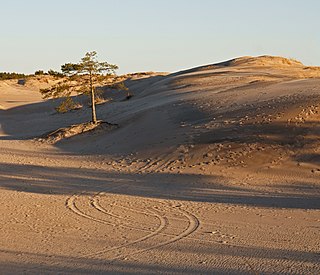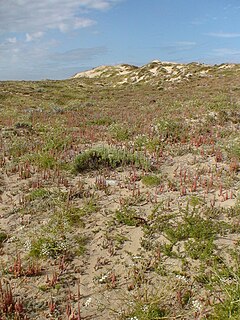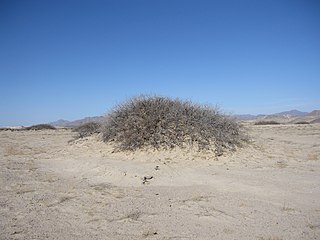 W
WA dune is a landform composed of wind- or water-driven sand. It typically takes the form of a mound, ridge, or hill. An area with dunes is called a dune system or a dune complex. A large dune complex is called a dune field, while broad, flat regions covered with wind-swept sand or dunes with little or no vegetation are called ergs or sand seas. Dunes occur in different shapes and sizes, but most kinds of dunes are longer on the stoss (upflow) side, where the sand is pushed up the dune, and have a shorter slip face in the lee side. The valley or trough between dunes is called a dune slack.
 W
WInland dunes are eolian sand dunes that are found inland, away from coastal regions.
 W
WA barchan or barkhan dune is a crescent-shaped dune. The term was introduced in 1881 by Russian naturalist Alexander von Middendorf, for crescent-shaped sand dunes in Turkestan and other inland desert regions. Barchans face the wind, appearing convex and are produced by wind action predominantly from one direction. They are a very common landform in sandy deserts all over the world and are arc-shaped, markedly asymmetrical in cross section, with a gentle slope facing toward the wind sand ridge, comprising well-sorted sand.
 W
WAn erg is a broad, flat area of desert covered with wind-swept sand with little or no vegetative cover. The word is derived from the Arabic word ʿarq (عرق), meaning "dune field". Strictly speaking, an erg is defined as a desert area that contains more than 125 km2 (48 sq mi) of aeolian or wind-blown sand and where sand covers more than 20% of the surface. Smaller areas are known as "dune fields". The largest hot desert in the world, the Sahara, covers 9 million square kilometres and contains several ergs, such as the Chech Erg and the Issaouane Erg in Algeria. Approximately 85% of all the Earth's mobile sand is found in ergs that are greater than 32,000 km2 (12,355 sq mi). Ergs are also found on other celestial bodies, such as Venus, Mars, and Saturn's moon Titan.
 W
WAn erg is a broad, flat area of desert covered with wind-swept sand with little or no vegetative cover. The word is derived from the Arabic word ʿarq (عرق), meaning "dune field". Strictly speaking, an erg is defined as a desert area that contains more than 125 km2 (48 sq mi) of aeolian or wind-blown sand and where sand covers more than 20% of the surface. Smaller areas are known as "dune fields". The largest hot desert in the world, the Sahara, covers 9 million square kilometres and contains several ergs, such as the Chech Erg and the Issaouane Erg in Algeria. Approximately 85% of all the Earth's mobile sand is found in ergs that are greater than 32,000 km2 (12,355 sq mi). Ergs are also found on other celestial bodies, such as Venus, Mars, and Saturn's moon Titan.
 W
WGrey dunes are fixed, stable sand dunes that are covered by a continuous layer of herbaceous vegetation. These dunes are typically located 50–100 meters from the ocean shore and are found on the landward side of foredunes. Grey dunes are named for their characteristic grey color which is a result of the ground cover of lichen combined with a top soil layer of humus.
 W
WAn ice dune, also called an ice ridge or an ice foot, is a formation of ice that accumulates on the shores of many arctic beaches and is also common along the shores of the Great Lakes during the winter. Ice dunes are not to be confused with ice shoves, which accumulate on bodies of water then push their way on shore, carrying sediment with them and deforming the shoreline.
 W
WAn interdunal wetland, interdunal pond or dune slack is a water-filled depression between coastal sand dunes. It may be formed either by wind erosion or by dunal encroachment on an existing wetland. The wind erosion process involves wind scooping out sufficient sand to reach the water table, and typically occurs behind the first line of foredunes.
 W
WA nabkha, nebkha or nebka is a type of sand dune. Other terms used include coppice dune and dune hummock or hummocky dune, but these more accurately refer to similar, but different, sand dune types. Authors have also used the terms phytogenic hillock, bush-mound, shrub-coppice dune, knob dune, dune tumulus, rebdou, nebbe, and takouit.
 W
WSand dune stabilization is a coastal management practice designed to prevent erosion of sand dunes. Sand dunes are common features of shoreline and desert environments. Dunes provide habitat for highly specialized plants and animals, including rare and endangered species. They can protect beaches from erosion and recruit sand to eroded beaches. Dunes are threatened by human activity, both intentional and unintentional. Countries such as the United States, Australia, Canada, New Zealand, the United Kingdom, and Netherlands, operate significant dune protection programs.
 W
WSinging sand, also called whistling sand or barking sand, is sand that produces sound. The sound emission may be caused by wind passing over dunes or by walking on the sand.
 W
WYellow dunes are sand dunes that develop after the first set of embryo dunes appear. With an average depth of about 5m, with a soil to sand ratio that is small on the soil side.